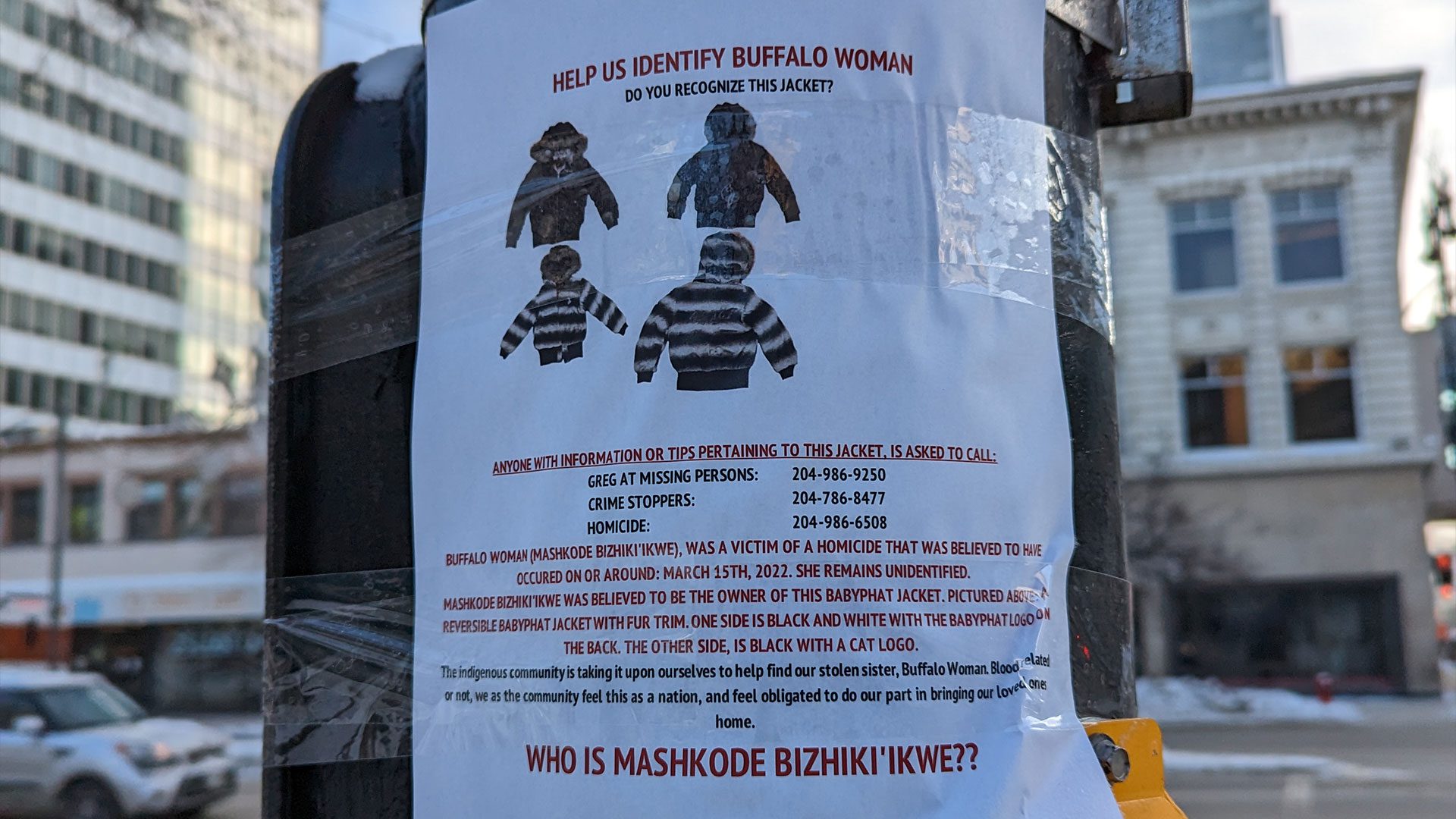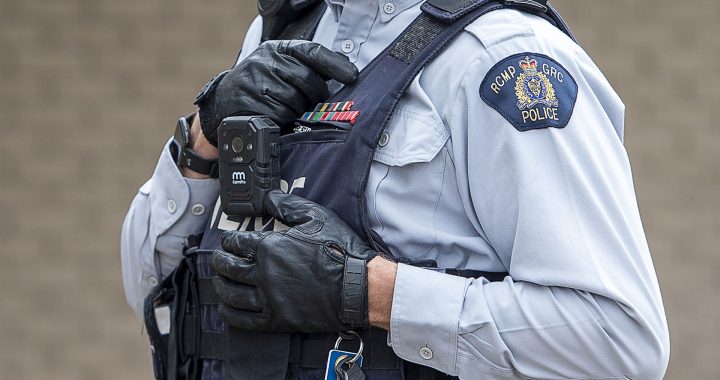Thelma Morrisseau and her partner Stanley La Pierre have come to an underpass on Portage Ave. in Winnipeg to offer tobacco to the spirits of the women and girls whose faces line the concrete walls on both sides.
“We need to come back here and offer some food and feed them,” Morrisseau says to her husband. In her Ojibway teachings of the Midewiwin Lodge, passed down from ancestors, she’s told to feed the spirits of loved ones who’ve left this world.
Morrisseau, from Crane River, and La Pierre recites the names of every girl and woman painted on these walls from memory. They knew all 10 on the mural. But for others who may not know the faces on this mural, their names are written underneath.
The faces and cases of missing and murdered Indigenous women and girls have been visible on this bridge for 13 years. Morrisseau takes note of the peeling paint and weeds growing, giving herself a “to do list” of the work that needs to be done to upkeep the area.
“I would like to see murals like this all over,” she says, “Like if we are looking at Manitoba, all the women and girls that have been taken should have one.”
Morrisseau is a retired social worker. Much of her career was spent in Winnipeg’s inner city, working first with families in the child welfare system, then moving to the Ma Mawi Wi Chi Itata Centre where she ran healing circles for sexually assaulted women and girls for almost 15 years.
Around the same time the murals went up in 2011, Morrisseau began working for the provincial government on MMIWG2S related matters.
Despite being around families for decades, she says this ‘heart work’ doesn’t get any easier.
Morrisseau’s brought APTN News here to talk about Buffalo Woman, in Anishinaabemowin, the name is Mashkode Bizhiki’ikwe.
Mural sits at the west door way where Buffalo Spirit is

One of the murals on the underpass walls portrays a white buffalo.
“Among the Sioux people that buffalo skull is really important as well,” Morrisseau says about the power and significance of a buffalo throughout First Nations across Turtle Island.
“They are always used in the sundance with the Dakota, Lakota people. So, it has lots of significance. You know you talk about the white buffalo calf woman, it has lots of significance to our people.”
Morrisseau is the main person who pushed to gift the name to the yet to be identified person that Jeremy Skibicki was recently found guilty of murdering. His other victims are Rebecca Contois, 24, Morgan Harris, 39, and Marcedes Myran, 26.
“I just felt very sad because no one was being identified as her family and as part of our cultural understanding is that we are all related,” Morrisseau says.
She says other grandmothers were involved in the process.
“Our community kind of adopted her, claimed her, well not just kind of, we have because she is our relative and she matters. She is important. She is loved,” Morrisseau says about Buffalo Woman.
After discussions, the Elders agreed to honour another traditional Midewiwin grandmother, Mary Roberts, who spoke of the buffalo spirit after one of her last fast and vision quests in the 1990s before she had passed on.
Morrisseau says that Roberts shared with her, the buffalo spirit told the fasting grandmother about the hard days ahead for Indigenous women and girls. So, the name would be gifted to all Indigenous women and girls and be used to describe those in need of protection.
“That spirit buffalo wanted to help and so one of the ways she wanted to do that was by giving all of us a name,” Morrisseau says of the teachings Roberts left behind, “It’s a beautiful name and it’s a beautiful gift to us as anishinaabe kwe women.”
Morrisseau says in the Midewiwin Lodge, the west door is the doorway spirits travel when they leave Earth, “It’s that doorway we dance out, but also in that doorway, the one that guards is that buffalo spirit.”
The murals on the bridge face toward the west. This was intentional, Morrisseau says because it signifies the women’s spirits went to the spirit world.
“For the longest time that buffalo spirit stood in that doorway guarding it for us on one leg. She did that with the belief and faith that one day we would begin to pick up our sacred bundles,” Morrisseau says as she acknowledges this has already started happening.
“People are picking up their sacred ceremonies, they are picking up their language, picking up their pipes, their sundances, their sweatlodges. everything, our beautiful bundle that the spirit gave to us that’s being picked up so some Elders talk about now that buffalo stands up on three legs, stronger.”
Significance of ceremony during Skibicki trial

Morrisseau says, that since Buffalo Woman was gifted her name, people began to see her as a real person who’s loved and missed.
Before the name, she was often called Jane Doe and Morrisseau says that name given to unidentified people often disassociates.
“What has happened to Buffalo Woman, Mashkode Bizhiki’ikwe could happen to anyone, anyone of us,” Morrisseau says.
“My daughter, she could be,” she says,” Or I could be her grandmother right or even her great grandmother. I could be that to her, for her and so I just see this as a really special honour that I could be able to see her in that way.”
“My hope is that her family, her birth family will be able to be identified.”
Morrisseau says naming Buffalo Woman also helped change a colonial court proceeding.
“We brought in a buffalo headdress and they, the courts were accepting of us placing that headdress in front of where the crown attorney was. Then we had an empty chair that signified Mashkode Bizhiki’Ikwe and on that chair we placed a beautiful red dress,” Morrisseau says, adding, it symbolizes the vision her teacher, Roberts had over 30 years ago.
“It could symbolize all the women that are still missing and not able to be identified.”
Read More:
Who is Buffalo Woman? Serial killer trial hears of police efforts to identify victim
Not much is known about the identity of Buffalo Woman. In the past, Winnipeg police have said she is likely an Indigenous woman and in her mid-20s.
The only DNA of hers was found on the cuff of the Baby Phat jacket similar to the one police circulated to the public.
During Skibicki’s trial, police revealed they have an investigator assigned full time to finding out Buffalo Woman’s identity. Other than this bit of information, not much else is said about her from police.
In an email statement, a police spokesperson tells APTN, “Given sentencing has not taken place, WPS will hold off on any follow up related to this trial.”
Skibicki’s sentencing date is scheduled for Aug. 28.









